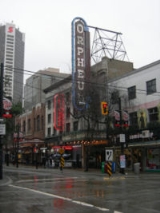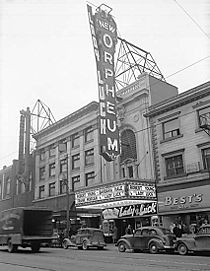
Orpheum, Vancouver
Encyclopedia
The Orpheum is a theatre and music venue in Vancouver
, British Columbia
. Along with the Queen Elizabeth Theatre and the Vancouver Playhouse, it is part of the Vancouver Civic Theatres group of live performance venues. The Orpheum is located on Granville Street
near Smithe Street in Vancouver's downtown core.
 Designed by Scottish architect Marcus Priteca
Designed by Scottish architect Marcus Priteca
, the theatre officially opened on November 7, 1927 as a vaudeville
house, but it hosted its first shows the previous day. The old Orpheum, at 761 Granville Street, was renamed the Vancouver Theatre (later the Lyric, then the International Cinema, then the Lyric once more before it closed for demolition in 1969 to make way for the first phase of the Pacific Centre
project). The New Orpheum, which was the biggest theatre in Canada when it opened in 1927, with three thousand seats, cost $1.25 million to construct. The first manager of the theatre was William A. Barnes.
Following the end of vaudeville's heyday in the early 1930s, the Orpheum became primarily a movie house under Famous Players
ownership, although it would continue to host live events on occasion. Ivan Ackery
managed the Orpheum during most of this period, from 1935 up until his 1969 retirement.
In 1973, for economic reasons, Famous Players decided to gut the inside of the Orpheum and change it into a multiplex. A "Save the Orpheum" public protest and fundraising campaign was launched, which even Jack Benny
flew in to help with, and the Orpheum was saved. On March 19, 1974, the City of Vancouver bought the theatre for $7.1 million, with $3.1 million coming from the city itself, and $1.5 million from each of the provincial and federal governments. The Orpheum closed in November 1975 and a renovation and restoration was done by the architectural company Thomson, Berwick, Pratt and Partners. It re-opened on April 2, 1977 and has since been the permanent home of the Vancouver Symphony Orchestra
. Tony Heinsbergen, a U.S. designer who originally chose the color scheme for the interior (ivory, moss green, gold and burgundy) was brought back, fifty years later, for the renovation. In 1983, an additional entrance was opened on Smithe Street.
In 2006, the Capitol Residences development was proposed for the old Capitol 6 cinema adjacent to the Orpheum. The City of Vancouver gave the developer permission for extra height and density on their site in return for a major expansion to the Orpheum, including a long desired back stage area. This was the largest amenities trade in the history of the city, and will increase the usability of the facility.
The Orpheum's neon
sign was donated by Jim Pattison
in the 1970s.

Vancouver
Vancouver is a coastal seaport city on the mainland of British Columbia, Canada. It is the hub of Greater Vancouver, which, with over 2.3 million residents, is the third most populous metropolitan area in the country,...
, British Columbia
British Columbia
British Columbia is the westernmost of Canada's provinces and is known for its natural beauty, as reflected in its Latin motto, Splendor sine occasu . Its name was chosen by Queen Victoria in 1858...
. Along with the Queen Elizabeth Theatre and the Vancouver Playhouse, it is part of the Vancouver Civic Theatres group of live performance venues. The Orpheum is located on Granville Street
Granville Street
Granville Street is a major street in Vancouver, British Columbia, Canada, and part of Highway 99.-Location:Granville Street runs generally north-south through the centre of Vancouver, passing through several neighbourhoods and commercial areas, differing appreciably in their land value and the...
near Smithe Street in Vancouver's downtown core.
History

B. Marcus Priteca
Benjamin Marcus Priteca was born in Glasgow, Scotland. A theater architect, he is best-known for his work for Alexander Pantages. He graduated from the University of Edinburgh in 1907 and later attended the Royal College of Art...
, the theatre officially opened on November 7, 1927 as a vaudeville
Vaudeville
Vaudeville was a theatrical genre of variety entertainment in the United States and Canada from the early 1880s until the early 1930s. Each performance was made up of a series of separate, unrelated acts grouped together on a common bill...
house, but it hosted its first shows the previous day. The old Orpheum, at 761 Granville Street, was renamed the Vancouver Theatre (later the Lyric, then the International Cinema, then the Lyric once more before it closed for demolition in 1969 to make way for the first phase of the Pacific Centre
Pacific Centre
Pacific Centre is a shopping mall located in Vancouver, British Columbia, Canada. It is operated by Cadillac Fairview Corporation. Based on the number of stores, many of which are underground, it is the largest mall in Downtown Vancouver with over 100 stores and services...
project). The New Orpheum, which was the biggest theatre in Canada when it opened in 1927, with three thousand seats, cost $1.25 million to construct. The first manager of the theatre was William A. Barnes.
Following the end of vaudeville's heyday in the early 1930s, the Orpheum became primarily a movie house under Famous Players
Cineplex Entertainment
Cineplex Entertainment LP , is the largest film exhibitor in Canada and owns, leases or has a joint-venture interest in 130 theatres with 1,351 screens. Headquartered in Toronto, Canada, Cineplex operates theatres from British Columbia to Quebec...
ownership, although it would continue to host live events on occasion. Ivan Ackery
Ivan Ackery
Ivan Ackery was a movie theatre manager and entertainment promoter in Vancouver, British Columbia. He was the manager of Vancouver's Orpheum Theatre during its peak period from the 1930s to the 1960s.-Early years:...
managed the Orpheum during most of this period, from 1935 up until his 1969 retirement.
In 1973, for economic reasons, Famous Players decided to gut the inside of the Orpheum and change it into a multiplex. A "Save the Orpheum" public protest and fundraising campaign was launched, which even Jack Benny
Jack Benny
Jack Benny was an American comedian, vaudevillian, and actor for radio, television, and film...
flew in to help with, and the Orpheum was saved. On March 19, 1974, the City of Vancouver bought the theatre for $7.1 million, with $3.1 million coming from the city itself, and $1.5 million from each of the provincial and federal governments. The Orpheum closed in November 1975 and a renovation and restoration was done by the architectural company Thomson, Berwick, Pratt and Partners. It re-opened on April 2, 1977 and has since been the permanent home of the Vancouver Symphony Orchestra
Vancouver Symphony Orchestra
The Vancouver Symphony Orchestra is a Canadian orchestra performing in Vancouver, British Columbia. Over 240,000 people attend its live performances each year. It was founded in 1930 and plays in 12 venues. Its home is the Orpheum theatre. With an annual operating budget of $9.5 million, it is the...
. Tony Heinsbergen, a U.S. designer who originally chose the color scheme for the interior (ivory, moss green, gold and burgundy) was brought back, fifty years later, for the renovation. In 1983, an additional entrance was opened on Smithe Street.
In 2006, the Capitol Residences development was proposed for the old Capitol 6 cinema adjacent to the Orpheum. The City of Vancouver gave the developer permission for extra height and density on their site in return for a major expansion to the Orpheum, including a long desired back stage area. This was the largest amenities trade in the history of the city, and will increase the usability of the facility.
The Orpheum's neon
Neon
Neon is the chemical element that has the symbol Ne and an atomic number of 10. Although a very common element in the universe, it is rare on Earth. A colorless, inert noble gas under standard conditions, neon gives a distinct reddish-orange glow when used in either low-voltage neon glow lamps or...
sign was donated by Jim Pattison
Jim Pattison
James Allen "Jim" Pattison, OC, OBC is a Vancouver-based Canadian entrepreneur who is the president, managing director, chief executive officer, chairman and sole owner of the Jim Pattison Group, the third largest privately held company in Canada...
in the 1970s.
See also

- List of heritage buildings in Vancouver
- List of concert halls
- Stanley Industrial Alliance StageStanley Industrial Alliance StageThe Stanley Industrial Alliance Stage is a landmark theatre at 12th and Granville Street in Vancouver, British Columbia which serves as the main stage for the Arts Club Theatre Company. The Stanley first opened as a movie theatre in December 1930, and showed movies for over sixty years before...
- Peter Wall

